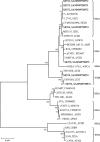Molecular Characterization and Comparative Genomics of Clinical Hybrid Shiga Toxin-Producing and Enterotoxigenic Escherichia coli (STEC/ETEC) Strains in Sweden
- PMID: 30948755
- PMCID: PMC6449507
- DOI: 10.1038/s41598-019-42122-z
Molecular Characterization and Comparative Genomics of Clinical Hybrid Shiga Toxin-Producing and Enterotoxigenic Escherichia coli (STEC/ETEC) Strains in Sweden
Abstract
Hybrid E. coli pathotypes are representing emerging public health threats with enhanced virulence from different pathotypes. Hybrids of Shiga toxin-producing and enterotoxigenic E. coli (STEC/ETEC) have been reported to be associated with diarrheal disease and hemolytic uremic syndrome (HUS) in humans. Here, we identified and characterized four clinical STEC/ETEC hybrids from diarrheal patients with or without fever or abdominal pain and healthy contact in Sweden. Rare stx2 subtypes were present in STEC/ETEC hybrids. Stx2 production was detectable in stx2a and stx2e containing strains. Different copies of ETEC virulence marker, sta gene, were found in two hybrids. Three sta subtypes, namely, sta1, sta4 and sta5 were designated, with sta4 being predominant. The hybrids represented diverse and rare serotypes (O15:H16, O187:H28, O100:H30, and O136:H12). Genome-wide phylogeny revealed that these hybrids exhibited close relatedness with certain ETEC, STEC/ETEC hybrid and commensal E. coli strains, implying the potential acquisition of Stx-phages or/and ETEC virulence genes in the emergence of STEC/ETEC hybrids. Given the emergence and public health significance of hybrid pathotypes, a broader range of virulence markers should be considered in the E. coli pathotypes diagnostics, and targeted follow up of cases is suggested to better understand the hybrid infection.
Conflict of interest statement
The authors declare no competing interests.
Figures


References
-
- Scheutz, F. Taxonomy Meets Public Health: The Case of Shiga Toxin-Producing Escherichia coli. Microbiol Spectr2, 10.1128/microbiolspec.EHEC-0019-2013 (2014). - PubMed
-
- Karmali, M. A. Host and pathogen determinants of verocytotoxin-producing Escherichia coli-associated hemolytic uremic syndrome. Kidney Int Suppl, S4–7, 10.1038/ki.2008.608 (2009). - PubMed
Publication types
MeSH terms
Substances
LinkOut - more resources
Full Text Sources

